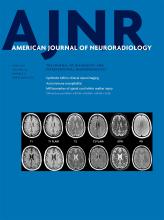Abstract
BACKGROUND AND PURPOSE: T2*-weighted imaging provides sharp contrast between spinal cord GM and WM, allowing their segmentation and cross-sectional area measurement. Injured WM demonstrates T2*WI hyperintensity but requires normalization for quantitative use. We introduce T2*WI WM/GM signal-intensity ratio and compare it against cross-sectional area, the DTI metric fractional anisotropy, and magnetization transfer ratio in degenerative cervical myelopathy.
MATERIALS AND METHODS: Fifty-eight patients with degenerative cervical myelopathy and 40 healthy subjects underwent 3T MR imaging, covering C1–C7. Metrics were automatically extracted at maximally compressed and uncompressed rostral/caudal levels. Normalized metrics were compared with t tests, area under the curve, and logistic regression. Relationships with clinical measures were analyzed by using Pearson correlation and multiple linear regression.
RESULTS: The maximally compressed level cross-sectional area demonstrated superior differences (P = 1 × 10−13), diagnostic accuracy (area under the curve = 0.890), and univariate correlation with the modified Japanese Orthopedic Association score (0.66). T2*WI WM/GM showed strong differences (rostral: P = 8 × 10−7; maximally compressed level: P = 1 × 10−11; caudal: P = 1 × 10−4), correlations (modified Japanese Orthopedic Association score; rostral: −0.52; maximally compressed level: −0.59; caudal: −0.36), and diagnostic accuracy (rostral: 0.775; maximally compressed level: 0.860; caudal: 0.721), outperforming fractional anisotropy and magnetization transfer ratio in most comparisons and cross-sectional area at rostral/caudal levels. Rostral T2*WI WM/GM showed the strongest correlations with focal motor (−0.45) and sensory (−0.49) deficits and was the strongest independent predictor of the modified Japanese Orthopedic Association score (P = .01) and diagnosis (P = .02) in multivariate models (R2 = 0.59, P = 8 × 10−13; area under the curve = 0.954, respectively).
CONCLUSIONS: T2*WI WM/GM shows promise as a novel biomarker of WM injury. It detects damage in compressed and uncompressed regions and contributes substantially to multivariate models for diagnosis and correlation with impairment. Our multiparametric approach overcomes limitations of individual measures, having the potential to improve diagnostics, monitor progression, and predict outcomes.
ABBREVIATIONS:
- AUC
- area under the curve
- CSA
- cross-sectional area
- DCM
- degenerative cervical myelopathy
- FA
- fractional anisotropy
- MCL
- maximally compressed level
- mJOA
- modified Japanese Orthopedic Association
- MT
- magnetization transfer
- MTR
- magnetization transfer ratio
- qMRI
- quantitative MRI
- SC
- spinal cord
- SCI
- spinal cord injury
- UE
- upper extremity
- © 2017 by American Journal of Neuroradiology
Indicates open access to non-subscribers at www.ajnr.org












